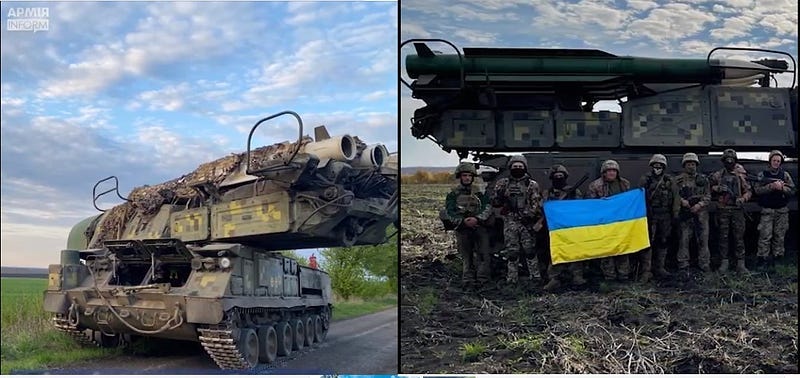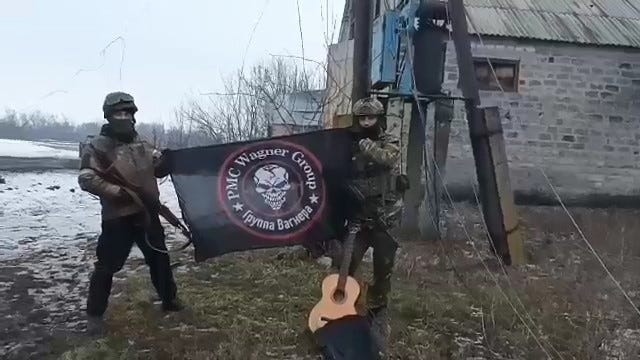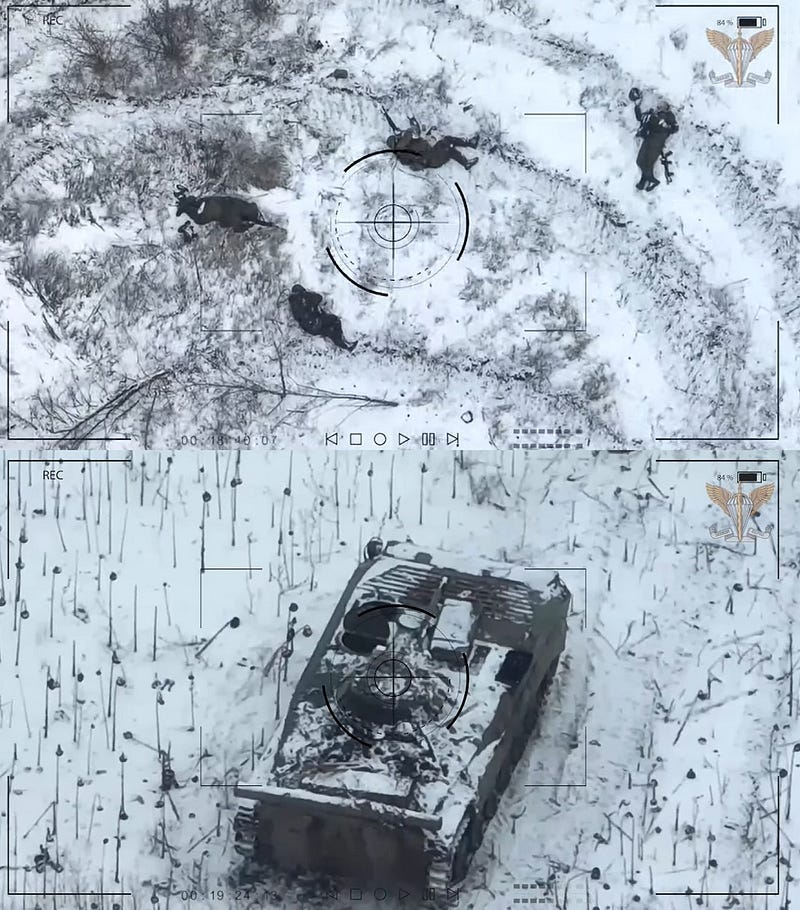Hello everybody!
Before I go on with commenting major developments on the strategic level of late January, here another update with a ‘rather’ operational-, even tactical character.
THE GOOD, THE BAD, AND THE UGLY
Up front….let me ‘reflect’ on the situation at the operational level. There’s no end of Ukrainian announcements about a pending Russian ‘biiiiiig’ offensive. Even some of top Western instances have joined Kyiv in this regards. Foremost: according to the same, this offensive has not been launched yet.
However, the more I’m cross-examining available info of the last few days, the more I’m convinced that this offensive is already in full swing. It’s just no ‘single stroke’ operation, where all the forces and assets would be concentrated on a single point of the frontline.
Now, lean back, take a deep breath and think about it. Sure, in the West we’ve been taught — indeed: indoctrinated — to expect ‘an onslaught of Soviet hordes’, back during the times of the (I) Cold War, like if Moscow’s stocks of troops and equipment would’ve been ‘endless’. However, at least nowadays, Putin does not have an endless supply of troops and equipment. Sure: his assets are ‘big’, but — as nicelly summarised by Pavel Luzin — they’ve got their limits, too.
As next, the last 11 months of this war have, once again, clearly demonstrated just how crucial for any kind of VDV’s and VSRF’s operations is the factor ‘logistics’. If logistics is not working, then entire armies of the VSRF are collapsing like houses of cards. Even Putin has learned that he can order whatever he likes, but neither the VDV nor the VSRF can advance if they haven’t got enough supplies.
Foremost: nowadays it’s not Putin who’s micromanaging this ‘game’ with help of his idiotic orders, but Gerasimov. He might be so deeply corrupt that the bosses of Mexican drug cartels are blushing in jealousy whenever his name is mentioned, and he might do well with some cosmetic surgery, but: he’s a smart strategist and working as hard as an ugly stripper.
Bottom line: the centrepiece of the Russian logistics are railways. The Russians are not getting anywhere in this war without functioning railway lines in their back. That’s why — between others — they didn’t ‘re-attack Kyiv from southern Belarus’, as expected by many, back in January, but their ‘big concentration of troops’ in that country turned out to be little else but re-building process of the 2nd Guards Motor Rifle Division (yes, the ‘famous’ Tamanskaya….). There aren’t enough suitable railways in that part of Ukraine to support (another) such drive.
That far, everything should be clear (or at least I hope it is).
Now, a ‘biiiig’ offensive would require Gerasimov to concentrate a huge stockpile of supplies. Matter of fact is: no matter what are Putler fans in the social media claiming, the Russian air defences have proven unable to protect even ‘medium-sized’ supply depots from Ukrainian strikes by M142s, M270s, Pnazerhaubitze 2000s, and Caesars. Even if always critically short on M30 GMLRS rockets, according to claims from Kyiv, regularly confirmed by reports from the local population, the ZSU is still blowing up at least another one of Russian depots, every single night. (The newest example: late on 1 February, the ZSU hit the VSRF military base in the school of Peshnaya, near Melitopol, reportedly housing 1,500 Russian troops at that time. According to local people, the building blew up and Russians are still collecting pieces…)
Because of that threat, Gerasimov can’t simply pile enough supplies around one sector of the frontline and then pile lots of troops and go attacking. A big concentration of troops in one spot, like one for a ‘single stroke’ operation, would
a) be easy to detect by NATO and Ukrainian intelligence- and reconnaissance assets (in turn enabling the ZSU to prepare suitably), and
b) would mean a lots of big supply depots, which in turn would be an excellent target for the Ukrainian long-range artillery.
Conclusion is on hand: he — read: Gerasimov’s deputies — has to spread and hide ‘his’ supplies. Preferably in plenty of places some 50–80km behind the frontline, and, preferably, in the rear of several sectors of the frontline.
My thesis is that this in turn results in Gerasimov running not ‘one biiiig’ offensive, but several ‘smaller’ ones (at least ‘smaller than expected’), and I see this as ‘confirmed’ by latest developments. The last week, we’ve seen one such operation in the Vuhledar area. Meanwhile it is certain that this is including some 4–5 full brigades (no ‘BTGs’), plus reinforcements, which means: something like a ‘full combined arms army’. Moreover, it’s becoming obvious that operations of similar or even larger size are run in the Kremina- and the Soledar-areas.
It’s a thesis of mine, no doubt, but considering ‘that’ with ‘limits in the number of troops the VDV and the VSRF can train and deploy at the same time’, and that with the ‘necessity to disperse supply stocks’, plus the VSRF’s limited ability to continue conducting offensive operations (resulting from the short duration of training of the mass of its mobilised reservists), that’s making perfect sense.
It’s making at least as much sense when one is cross-examining different other developments on the operational- and tactical plan. For example: multiple Russian sources are reporting something like ‘reinforced hunt for Ukrainian air defences’, which ‘not only became a concern for the VKS but all other branches of the Russian armed forces’ — i.e. a large-scale effort in what the West calls ‘Suppression of Enemy Air Defences’, or SEAD.
Sure, details are lacking. Right now, I can only say this is run foremost by VKS’ units equipped with Su-34s, and with help of Kh-31s and Kh-59s, and some seem to be underplaying the situation by explaining the VKS is after a very specific Buk M1 SAM-site in particular (i.e. an Ukrainian unit that caused them several very unpleasant losses). But, in the case of modern air warfare it is ‘normal’ not to release any kind of details until ‘well after’, and thus I do not expect them to surface very soon. Too much is at stake. Points are:
A) fact is that there are such reports, which means such operations are already run since some time (probably two weeks, if not longer), and
B) nobody is running a major SEAD effort ‘for nothing’: such operations are extremely complex, time-consuming, and costly, and — except one is NATO fighting Serbia without ground troops of 1999 — undertaken only in support of ground operations.
BATTLE OF KREMINA
Now to the developments at the tactical level…
Kremina….while Ukrainians reported that the expected major Russian offensive in this area wasn’t launched the last two days, the Russians report it was. According to them, this operation — centred on the (full) 76th VDV Division and the BARS-13 — is run ‘in direction of Krasny Lyman, and that in three prongs from the villages of Chernopopivka, Zhitlivka, and from Kremina, via Dibrova towards north-west, west and south-west. Some are reporting Russian attacks all the way along the P066 up to Nevske and Ploshchanka, and the capture of Bilohorivka, too, while Ukrainian reports are indicating the ZSU repelling the assault on Yampolivka. Guess, we’ll have to wait and see what comes out of this.
THE SOLEDAR DEBATING CLUB AND ITS ‘FAGGOT’ GENERALS
Usually, I’m ‘grouping’ situational-reports form the Donbass all into one under the title ‘Battle of Donbass’. In the case of developments in the area between Siversk and Bakhmut, I’ll make an exception for very specific reasons.
While Wagner’s convicts are de-facto ‘spent’ (or at least in need of urgent reinforcements), and what was left of them has been moved away from Bakhmut, they have joined the general Russian advance, which was meanwhile re-directed north of the town. Indeed: north of Soledar. More specifically: in between of Siversk and Bakhmut. The way I see it, what’s going on there the last three days is the best confirmation for my thesis that the ‘biiiiiiig’ Russian offensive is very much already taking place.
Sure, it’s nothing like one might have expected the VDV and the VSRF to run before this war (see: ‘hordes of mechanised units driving deep into the Ukrainian rear’), but it is a massive push and its results are ‘getting unpleasant’. Instead, it’s a slow, methodical, combined arms operation, with intensive air- and ‘Russian-style’ artillery support.
What’s worst: thanks to commanders of ZSU brigades and battalions deployed in the area north of Soledar continuing to behave like members of that ‘legendary’ Soledar Debating Club, the Russians — which is: their 7th Guards VDV Division, reinforced by elements of the 2nd and 120 Guards Motor Rifle Divisions — have breached the Ukrainian frontline at the width of some 4–5km and secured the hamlets of Nikolaevka/Mykolaivka and Sakke i Vantsetti, north of Soledar and about 7–8km north of Bakhmut, the last two days. Surviving Wagner-convicts were then quick to take selfies of them there.
How concerning this became for the East OK of the ZSU is obvious from the fact that not only was the 241st TD Brigade (a well-equipped unit from Kyiv, which used to be deployed inside Bakhmut) re-deployed towards north, has counterattacked into Blahodatne and recovered at least a part of the village: even the crack 93rd Mech is back on the scene and meanwhile trying to stop the Russian advance in between of Siversk and Bakhmut.
…with which I’m back to the ‘old’ discussion about the East OK’s practice of ‘pilling’ different units along a narrow sector of the frontline, and thus creating a chaos in the chain of command; BUT, and ESPECIALLY the lack of discipline of specific ZSU field commanders and their ‘resistance to faggot generals’.
The list of units deployed along the frontline between Siversk (in the north) and Bakhmut (in the south) meanwhile resembles the roster of half the ZSU; at least it reminds of the situation in the Soledar-Bakhmut area of early January. AFAIK, there are elements of the 4th and 17th Tank, 10th Mountain, 46th Airborne, 61st Mech, 77th Airborne, 113th and 115th TD, 128th Mountain Assault, plus 43rd Artillery and several minor ‘special forces’ assets… and still, the Russians are advancing — usually thanks to insubordination of Ukrainian field commanders, which in turn is what required that recall of the 93rd Mech from its (well-deserved) vacation…
Now, when such things happen, then it’s a matter of fact: gentlemen, you’ve all screwed up, no matter how independent-minded, well-trained, how combat-experienced and super-clever and whatever else you all might be. And that at the cost of your troops and equipment. Face it, accept it, and start following your orders, finally: you can discuss them before and after the action, but not while the action is taking place, and especially not if you’ve — repeatedly — been proven wrong. Otherwise, the GenStab-U will be doing better if wasting time and resources by deploying you and your units for an invasion of Vanuatu….
Point is: like in Soledar back in early January, the ZSU has enough forces to stop this Russian advance. However, unless the East OK sorts out the chain of command, and those under its control start following their orders, things are unlikely to experience any kind of a dramatic change.
SOUTHERN BAKHMUT & VUHLEDAR
Bakhmut… elsewhere… i.e. south: I might be wrong, but the ZSU seems to still be holding out on that crucial hill above Klishchivka, but the Russians kept on pushing into the valley south and then west of that village, approaching Ivanivske and the road T0504, connecting Bakhmut with Kostyantynivka. That this is another of ‘slow, methodical’ — but powerful — Russian drives is obvious from the fact that three ZSU brigades are struggling to stop the advance on Chasiv Yar and Ivanivske.
Vuhledar… well, when Rybar says that the ‘weather is bad’ and ‘offensive was put on hold’…. you know what’s going on. Actually, the VSRF continued running small scale attacks, but didn’t manage anything else but to lose few additional IFV and troops. Quite ironic to watch the Russians having no solution for crossing kilometres of open space in the face of murderously precise Ukrainian artillery fire…
Don’t worry: they’re going to try again — at least as soon as the HQ 58th CAA finds enough troops that haven’t experienced what the 40th and the 155th Naval Infantry Brigades experienced the last week.








